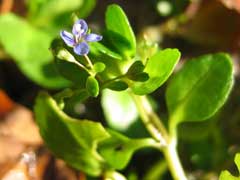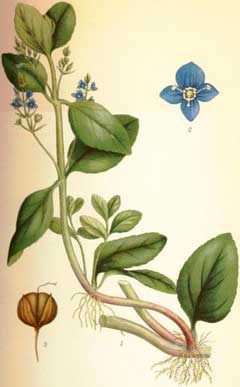 |
|
commons.wikimedia.org/wiki/User:Fabelfroh |
 |
| commons.wikimedia.org/wiki/File:Veronica_beccabunga_bäckveronika.jpg |
Translate this page:
Summary
Physical Characteristics

 Veronica beccabunga is a PERENNIAL growing to 0.6 m (2ft).
Veronica beccabunga is a PERENNIAL growing to 0.6 m (2ft).
See above for USDA hardiness. It is hardy to UK zone 5 and is not frost tender. It is in flower from May to September, and the seeds ripen from July to September. The species is hermaphrodite (has both male and female organs) and is pollinated by Flies, bees. The plant is self-fertile.
It is noted for attracting wildlife.
Suitable for: light (sandy), medium (loamy) and heavy (clay) soils. Suitable pH: mildly acid, neutral and basic (mildly alkaline) soils. It can grow in semi-shade (light woodland) or no shade. It prefers wet soil and can grow in water.
UK Hardiness Map
US Hardiness Map
Synonyms
Plant Habitats
Woodland Garden Sunny Edge; Pond; Bog Garden;
Edible Uses
Edible Parts: Leaves
Edible Uses:
Leaves - raw or cooked[2, 4, 5, 115]. They can be added to salads, mixed with water cress or cooked with other strongly flavoured greens[9, 183]. A pungent flavour, although the leaves are wholesome they are not very palatable[4, 12].
References More on Edible Uses
Medicinal Uses
Plants For A Future can not take any responsibility for any adverse effects from the use of plants. Always seek advice from a professional before using a plant medicinally.
Alterative Antiscorbutic Diuretic Emmenagogue Febrifuge Poultice
The whole plant is alterative, antiscorbutic, very mildly diuretic, emmenagogue and febrifuge[4, 9, 13, 21]. It is of little benefit as a medicinal herb, but has a beneficial laxative effect when included in the diet[9]. The leaves are used in the treatment of scurvy, impurity of the blood etc[240]. The plant is bruised and applied externally as a politic on burns, ulcers, whitlows, etc[240].
References More on Medicinal Uses
The Bookshop: Edible Plant Books
Our Latest books on Perennial Plants For Food Forests and Permaculture Gardens in paperback or digital formats.

Edible Tropical Plants
Food Forest Plants for Hotter Conditions: 250+ Plants For Tropical Food Forests & Permaculture Gardens.
More

Edible Temperate Plants
Plants for Your Food Forest: 500 Plants for Temperate Food Forests & Permaculture Gardens.
More

More Books
PFAF have eight books available in paperback and digital formats. Browse the shop for more information.
Shop Now
Other Uses
References More on Other Uses
Cultivation details
Easily grown in a moderately fertile wet soil, growing best in water up to 15cm deep[24, 200]. Prefers cool summers[200]. Plants do not demand high light levels[200]. A good bee plant[24].
References Carbon Farming Information and Carbon Sequestration Information
Temperature Converter
Type a value in the Celsius field to convert the value to Fahrenheit:
Fahrenheit:
The PFAF Bookshop
Plants For A Future have a number of books available in paperback and digital form. Book titles include Edible Plants, Edible Perennials, Edible Trees,Edible Shrubs, Woodland Gardening, and Temperate Food Forest Plants. Our new book is Food Forest Plants For Hotter Conditions (Tropical and Sub-Tropical).
Shop Now
Plant Propagation
Seed - sow autumn in a cold frame. When they are large enough to handle, prick the seedlings out into individual pots and plant them out in the summer. If you have sufficient, the seed can be sown in situ in the spring or the autumn. Division at almost any time in the growing season. Very easy, even a small part of the plant will root if put in water[K].
Other Names
If available other names are mentioned here
Native Range
TEMPERATE ASIA: Afghanistan, Egypt (Sinai), Iran, Iraq, Lebanon, Turkey (Adana, Bingöl, Bolu, Denizli, Erzurum, Giresun, Hakkâri, Isparta, Kastamonu, Kayseri, Maras, Nigde, Ordu, Rize, Samsun, Tunceli, Van), Russian Federation-Ciscaucasia (Ciscaucasia), Armenia, Azerbaijan, Georgia, Russian Federation (Dagestan), Russian Federation-Western Siberia (Western Siberia), Kazakhstan, Kyrgyzstan, Tajikistan, Turkmenistan, Uzbekistan, Mongolia, China (Sichuan Sheng (southwest), Yunnan Sheng (northwest), Xinjiang Uygur Zizhiqu) TROPICAL ASIA: India (north), Nepal, Pakistan EUROPE: Denmark, Finland, Faroe Islands, United Kingdom, Ireland, Iceland (possibly), Norway, Sweden, Austria, Belgium, Switzerland, Czech Republic, Germany, Hungary, Netherlands, Poland, Slovakia, Russian Federation (European part), Belarus, Estonia, Lithuania, Latvia, Moldova, Ukraine (incl. Krym), Albania, Bulgaria, Greece, Croatia, Italy (incl. Sardinia, Sicily), Romania, Serbia, Slovenia, Turkey (Kirklareli), Spain, France (incl. Corsica), Portugal AFRICA: Spain (Canarias), Algeria (north), Egypt, Morocco, Tunisia, Ethiopia
Weed Potential
Right plant wrong place. We are currently updating this section.
Please note that a plant may be invasive in one area but may not in your area so it's worth checking.
Conservation Status
IUCN Red List of Threatened Plants Status :

| Related Plants
|
| Latin Name | Common Name | Habit | Height | Hardiness | Growth | Soil | Shade | Moisture | Edible | Medicinal | Other |
| Veronica agrestis | Field Speedwell, Green field speedwell | Annual | 0.1 |
0-0
| | LMH | N | M | 1 | 1 | 0 |
| Veronica americana | American Brooklime, American speedwell | Perennial | 0.1 |
0-0
| | LMH | SN | WeWa | 2 | 1 | |
| Veronica anagallis-aquatica | Water Speedwell | Perennial | 0.3 |
-
| | LMH | N | WeWa | 2 | 2 | |
| Veronica arvensis | Corn Speedwell | Annual | 0.2 |
4-8
| | LMH | N | DM | 0 | 1 | 0 |
| Veronica catenata | | Perennial | 0.0 |
-
| | LMH | N | WeWa | 1 | 0 | |
| Veronica chamaedrys | Germander Speedwell | Perennial | 0.5 |
3-7
| | LMH | SN | M | 1 | 1 | |
| Veronica hederifolia | Ivy-Leaf Speedwell | Annual | 0.5 |
-
| | LMH | N | M | 0 | 1 | |
| Veronica longifolia | Garden Speedwell, Long-Leaf Speedwell | Perennial | 1.0 |
4-10
| M | LMH | N | M | 1 | 0 | |
| Veronica officinalis | Common Speedwell | Perennial | 0.1 |
3-7
| | LMH | SN | DM | 1 | 2 | |
| Veronica peregrina | Necklace Weed, Neckweed, Hairy purslane speedwell | Annual/Biennial | 0.2 |
0-0
| | LMH | N | MWe | 0 | 2 | 0 |
| Veronica polita | Gray field speedwell | Annual | 0.3 |
0-0
| | LMH | N | M | 2 | 1 | |
| Veronica scutellata | Marsh Speedwell, Skullcap speedwell | Perennial | 0.1 |
5-9
| | LMH | N | WeWa | 1 | 0 | |
| Veronica spuria | bastard speedwell | Perennial | 0.5 |
3-7
| | LMH | N | M | 1 | 0 | |
| Veronica undulata | Undulate speedwell | Perennial | 1.0 |
0-0
| | LMH | N | MWe | 1 | 1 | |
| Veronicastrum axillare | | Perennial | 1.8 |
-
| | LMH | N | M | 0 | 2 | |
| Veronicastrum sibiricum | Blackroot | Perennial | 0.8 |
5-9
| | LMH | SN | M | 0 | 2 | |
| Veronicastrum virginicum | Beaumont's Root, Culver's root, Bowman's Root, Culver's Root, Black Root | Perennial | 1.2 |
3-9
| F | LMH | N | M | 0 | 3 | |
|
Growth: S = slow M = medium F = fast. Soil: L = light (sandy) M = medium H = heavy (clay). pH: A = acid N = neutral B = basic (alkaline). Shade: F = full shade S = semi-shade N = no shade. Moisture: D = dry M = Moist We = wet Wa = water.
Now available:
Food Forest Plants for Mediterranean Conditions
350+ Perennial Plants For Mediterranean and Drier Food Forests and Permaculture Gardens.
[Paperback and eBook]
This is the third in Plants For A Future's series of plant guides for food forests tailored to
specific climate zones. Following volumes on temperate and tropical ecosystems, this book focuses
on species suited to Mediterranean conditions—regions with hot, dry summers and cool, wet winters,
often facing the added challenge of climate change.
Read More
Expert comment
Author
L.
Botanical References
17200
Links / References
For a list of references used on this page please go here
Readers comment
| Add a comment |
|
If you have important information about this plant that may help other users please add a comment or link below. Only comments or links that are felt to be directly relevant to a plant will be included. If you think a comment/link or information contained on this page is inaccurate or misleading we would welcome your feedback at [email protected]. If you have questions about a plant please use the Forum on this website as we do not have the resources to answer questions ourselves.
* Please note: the comments by website users are not necessarily those held by PFAF and may give misleading or inaccurate information.
To leave a comment please Register or login here All comments need to be approved so will not appear immediately.
|
Subject : Veronica beccabunga
|
|
|
|